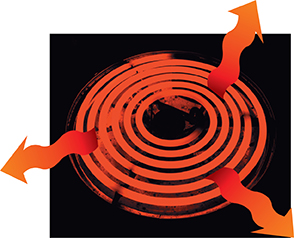Baking instructions sometimes tell you to use the top rack of an oven. Figure 7B shows why the temperature is lower at the top of the oven. When air at the bottom of the oven heats up, it expands and becomes less dense than the surrounding air. Due to the difference in density, the hot air rises. The rising air cools as it moves away from the heat source. As a result, the coolest air is at the top of the oven.
Air circulating in an oven is an example of a convection current. A convection current occurs when a fluid circulates in a loop as it alternately heats up and cools down. In a heated room, convection currents help keep the temperature uniform throughout the room.
 Convection currents are important in many natural cycles, such as ocean currents, weather systems, and movements of hot rock in Earth's interior.
Convection currents are important in many natural cycles, such as ocean currents, weather systems, and movements of hot rock in Earth's interior.
Radiation
At a picnic, you might use a charcoal grill to cook food. When you stand to the side of the grill, heat reaches you without convection or conduction. In much the same way, the sun warms you by radiation on a clear day. The space between the sun and Earth has no air to transfer thermal energy. Radiation is the transfer of energy by waves moving through space. Heat lamps used in restaurants are a familiar example of radiation.
 All objects radiate energy. As an object's temperature increases, the rate at which it radiates energy increases. In Figure 8, the electric heating coil on a stove radiates so much energy that it glows. If you are close to the heating coil, you absorb radiation, which increases your thermal energy. In other words, it warms you up. The farther you are from the heating coil, the less radiation you receive, and the less it warms you.
All objects radiate energy. As an object's temperature increases, the rate at which it radiates energy increases. In Figure 8, the electric heating coil on a stove radiates so much energy that it glows. If you are close to the heating coil, you absorb radiation, which increases your thermal energy. In other words, it warms you up. The farther you are from the heating coil, the less radiation you receive, and the less it warms you.

What is radiation?
Quick Lab
Observing Convection
Procedure 
Fill a 100-mL beaker halfway with cold water.
Fill a dropper pipet with hot water colored with food coloring. Wipe the pipet with a paper towel so no food coloring is on the outside of the pipet.
Insert the tip of the pipet into the cold water, halfway between the surface of the water and the bottom of the beaker.
Slowly squeeze the pipet bulb. Observe the water in the beaker from the side.
Analyze and Conclude
Observing Describe the motion of the colored hot water in the beaker.
Inferring Explain why the hot water behaved as it did.
Predicting How would colored cold water move in a beaker of hot water?

Figure 8 A heating coil on a stove radiates thermal energy. The changing color of the red arrows indicates that the farther you are from the coil, the less radiation you receive.




